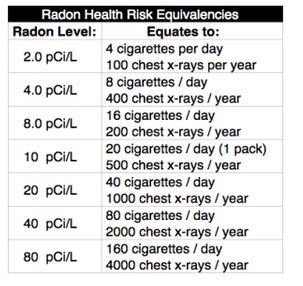FAQsDid you know?
90% of the time, depending on your home's structure, you can route your radon system indoors eliminating the need to have your system appear obtrusive. A1 Radon Services, LLC, an Authorized Pro with over 20+ years of construction and remodeling experience, understands the structure of your home and will be able to route your system in a non-obtrusive manner if at all possible. What is Radon?
Radon is a cancer-causing, radioactive gas. You can't see, smell or taste radon but it may be a problem in your home. Radon is estimated to cause thousands of deaths per year. That's because when you breathe air containing radon, you can get lung cancer. In fact, the Surgeon General has warned that radon is the second leading cause of lung cancer in the United States today. Only smoking causes more lung cancer deaths. If you smoke, and your home has high radon levels, your risk of lung cancer is especially high. Where can you find Radon? Radon can be found all over the U.S. It comes from the natural (radioactive) breakdown of uranium in soil, rock and water and gets into the air you breathe. It can get into any type of building, homes, offices, and schools, and results in a high indoor radon level. However, you and your family are most likely to get your greatest exposure at home where you spend most of your time. How dangerous is Radon? Radon is a Class A carcinogen and is the number one cause of lung cancer in non-smokers and the second leading cause of lung cancer (after tobacco) in smokers. The EPA estimates that Radon kills more than 22,000 people in the USA each year. Thankfully, this risk should be entirely preventable through awareness, testing and mitigation. Radon Health Risk Equivalencies: How serious a problem is Radon in Minnesota?
High radon levels exist in every state in the US. In Minnesota, 2 in 5 homes have radon levels that pose a significant health risk, and nearly 80% of counties are rated with high radon zones. Some factors that further contribute to Minnesota's high radon levels include:
What are Three ways to protect you and your family from Radon? 1. Test your home - obtain a test kit. To find where to purchase a test kit, click here 2. Reduce your exposure - reduce radon gas by taking action to reduce radon entry into your home. 3. Protect your loved ones - tell your family and friends to test so they are not exposed to deadly gas in their homes. Why should you test for Radon? The only way to know if you and your family are at risk for radon is to test your home. Just because your neighbor tested, and has high or low levels of radon, does not mean the same goes for your house. Radon levels vary from house to house and the EPA and the Surgeon General recommend testing all homes below the third floor for radon. The EPA recommends testing for radon and reducing radon in homes with high levels. Fix your home if your radon level is 4 Pico curries per liter (pCi/L) or higher. There is no "safe" level of Radon; you may wish to mitigate your home even if levels are above 2 Pico curries. EPA also recommends testing in schools. Testing is inexpensive and easy — it should only take a few minutes of your time. Millions of Americans have already tested their homes for radon (see how to test your home). What does EPA recommend?
|
ResourcesEnvironmental Protection Agency Radon Site
www.epa.gov NRPP National Radon Proficiency Program (NRPP) Phone (toll free): (800) 269-4174 or (828) 890-4117 Minnesota Department of Health www.health.state.mn
The American Association of Radon Scientists & Technologists http://www.aarst.org/ Air Chek Radon Test Kits A good source for reliable, objective and affordable test kits. Toll-free (800) AIR-CHEK (247-2435) http://www.radon.com State Radon Info Locator http://state-radon.info Minnesota County Radon Information http://mn-radon.info/MN_counties.html "Radon: Keeping Your Home Safe" Download PDF CanSAR – Cancer Survivors Against Radon http://www.cansar.org/ Radon Wikipedia page http://en.wikipedia.org/wiki/Radon NRSB
National Radon Safety Board (NRSB) Phone: (866) 329-3474 AARST Is a nonprofit, professional organization of members who are dedicated to the highest standard of excellence and ethical performance of radon measurement, radon mitigation and transfer of radon information for the benefit of members, consumers and the public at large." American Association of Radon Scientists & Technologists, Inc. (AARST) Phone (toll free): 866-772-2778 Purchase radon test kits by phone
|
|
What are average costs?
The cost for radon mitigation can vary by region based on the home’s construction style, soil, and radon levels. Installing a mitigation system in a typical single family home, in the Minnesota area, generally can range anywhere from $1,500-$2,500. However, costs could run lower or higher depending on the home’s construction, soil, and radon levels as mentioned previously. For accurate pricing, request a quote from us today: How to select a Radon mitigation contractor?
Make sure the contractor you choose is certified. Unlike many states, Minnesota does not require radon mitigation contractors to be licensed. However, the Minnesota Department of Health lists contractors who are certified by NEHA (The National Environmental Health Administration is chartered by the EPA to provide certification services in the United States). Also, make sure the contractor is insured, offers a written contract and guarantee, and ask for references. Having an Authorized Pro mitigator, like A1 Radon Services, LLC, guarantees all these requirements. Remember... If your radon mitigator is unable to route your system in a non obtrusive manner, you might want a second opinion. 90% of the time, depending on your home's structure, you can route your radon system indoors eliminating the need to have your system appear obtrusive. A1 Radon Services, LLC, an Authorized Pro with over 20+ years of construction and remodeling experience, understands the structure of your home and is a leading expert in non obtrusive routing. |

